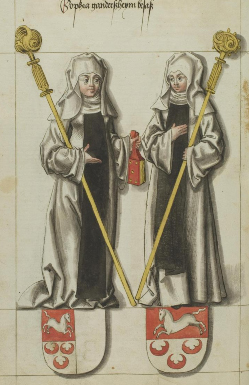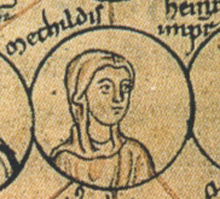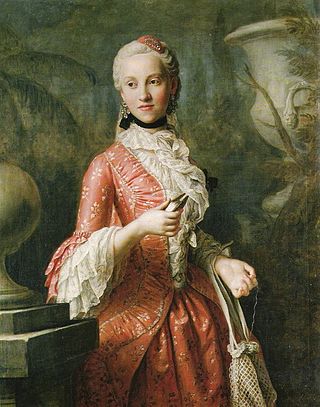Ezzo, sometimes called Ehrenfried, a member of the Ezzonid dynasty, was Count Palatine of Lotharingia from 1015 until his death. As brother-in-law of Emperor Otto III, father of Queen Richeza of Poland and several other illustrious children, he was one of the most important figures of the Rhenish history of his time.
Blankenheim may refer to:

The Obermünster, or Obermünster Abbey, Regensburg, was a collegiate house of canonesses (Frauenstift) in Regensburg, Bavaria, second only to Niedermünster in wealth and power.

Gandersheim Abbey is a former house of secular canonesses (Frauenstift) in the present town of Bad Gandersheim in Lower Saxony, Germany. It was founded in 852 by Duke Liudolf of Saxony, progenitor of the Liudolfing or Ottonian dynasty, whose rich endowments ensured its stability and prosperity.

Gernrode Abbey was a house of secular canonesses (Frauenstift) in Gernrode in what is now Saxony-Anhalt, Germany. Gernrode was founded in 959 and was disestablished in the seventeenth century. In the Middle Ages the abbey was an Imperial abbey, which had the status of imperial immediacy, and an Imperial State. In the early modern period, the abbey was part of the Upper Saxon Circle.
Saint Altfrid was a leading figure in Germany in the ninth century. A Benedictine monk, he became Bishop of Hildesheim, and founded Essen Abbey. He was also a close royal adviser to the East Frankish King Louis the German.

Countess Palatine Francisca Christina of Sulzbach was the Princess-abbess of Essen Abbey and Thorn Abbey. She led Essen Abbey from 1726 to 1776, the longest of any Essen abbess. Her tenure was marked by disputes between the Abbey and the city, which were caused by her counselors.

Sophia I, a member of the royal Ottonian dynasty, was Abbess of Gandersheim from 1002, and from 1011 also Abbess of Essen. The daughter of Emperor Otto II and his consort Theophanu, she was an important kingmaker in medieval Germany.

Matilda, Countess Palatine of Lotharingia, was a member of the Ottonian dynasty.

Thorn Abbey or the Imperial Abbey of Thorn was an imperial abbey of the Holy Roman Empire in what is now the Netherlands. It was founded in the 10th century and remained independent until 1794, when it was occupied by French troops. The self-ruling abbey enjoyed imperial immediacy and belonged to the Lower Rhenish-Westphalian Circle.
Henry of Berg, Lord of Windeck was the son of Adolf VII of Berg and Margaret of Hochstaden. He was the younger brother of Adolf VIII of Berg and William I of Berg.
Anna Salome of Manderscheid-Blankenheim was Abbess of Thorn Abbey from 1648 to 1688, and the abbess of Essen Abbey from 1688 until her death.
Clara Elisabeth of Manderscheid-Blankenheim was canoness at Thorn Abbey and Essen Abbey and deaness at Elten Abbey. In Thorn, she is known today as "the sick lady" and she is better known than her sister Anna Salome, although the latter presided over Thorn Abbey for more than 40 years as abbess. In 1673, Clara Elizabeth donated a Loreto Chapel. A magnificent epitaph in the St. Michael Church, the former Abbey Church, in Thorn, commemorates her.
Wirich VI, Count of Daun-Falkenstein was a German nobleman, diplomat, statesman, and politician. By descent, he was a Count of Falkenstein, and by inheritance, he was Lord of Broich and Lord of Bürgel. He belonged to the lower nobility in the Duchy of Berg and was a member of the Estates of Berg. He supported the Reformation in the Lower Rhine area.

Maria Kunigunde of Saxony was Princess-Abbess of Essen and Thorn. She was a titular Princess of Poland, Lithuania and Saxony of the Albertine branch of the House of Wettin. She was a member of the Order of the Starry Cross and a collegiate lady in the abbey at Münsterbilzen.

The Cross of Otto and Mathilde, Otto-Mathilda Cross, or First Cross of Mathilde is a medieval crux gemmata processional cross in the Essen Cathedral Treasury. It was created in the late tenth century and was used on high holidays until recently. It is named after the two persons who appear on the enamel plaque below Christ: Otto I, Duke of Swabia and Bavaria and his sister, Mathilde, the abbess of the Essen Abbey. They were grandchildren of the emperor Otto I and favourites of their uncle, Otto II. The cross is one of the items which demonstrate the very close relationship between the Liudolfing royal house and Essen Abbey. Mathilde became Abbess of Essen in 973 and her brother died in 982, so the cross is assumed to have been made between those dates, or a year or two later if it had a memorial function for Otto. Like other objects in Essen made under the patronage of Mathilde, the location of the goldsmith's workshop is uncertain, but as well as Essen itself, Cologne has often been suggested, and the enamel plaque may have been made separately in Trier.

Mathilde was Abbess of Essen Abbey from 973 to her death. She was one of the most important abbesses in the history of Essen. She was responsible for the abbey, for its buildings, its precious relics, liturgical vessels and manuscripts, its political contacts, and for commissioning translations and overseeing education. In the unreliable list of Essen Abbesses from 1672, she is listed as the second Abbess Mathilde and as a result, she is sometimes called "Mathilde II" to distinguish her from the earlier abbess of the same name, who is meant to have governed Essen Abbey from 907 to 910 but whose existence is disputed.

The Cross of Mathilde is an Ottonian processional cross in the crux gemmata style which has been in Essen in Germany since it was made in the 11th century. It is named after Abbess Mathilde who is depicted as the donor on a cloisonné enamel plaque on the cross's stem. It was made between about 1000, when Mathilde was abbess, and 1058, when Abbess Theophanu died; both were princesses of the Ottonian dynasty. It may have been completed in stages, and the corpus, the body of the crucified Christ, may be a still later replacement. The cross, which is also called the "second cross of Mathilde", forms part of a group along with the Cross of Otto and Mathilde or "first cross of Mathilde" from late in the preceding century, a third cross, sometimes called the Senkschmelz Cross, and the Cross of Theophanu from her period as abbess. All were made for Essen Abbey, now Essen Cathedral, and are kept in Essen Cathedral Treasury, where this cross is inventory number 4.
The Vilich Abbey is a former monastery located in North Rhine-Westphalia. It is named after the canonized Adelaide of Vilich, who lived from 970 to 1015. After her death, a cult formed around her and the convent. The convent was terminated in 1804 due to secularization. It was destroyed during the Thirty Years´ war and rebuilt. The Franciscans took over the abbey as a hospital in 1865, followed by many different charitable institutions. The church was destroyed in World War II and once again restored, and is now used as a retirement home.


















